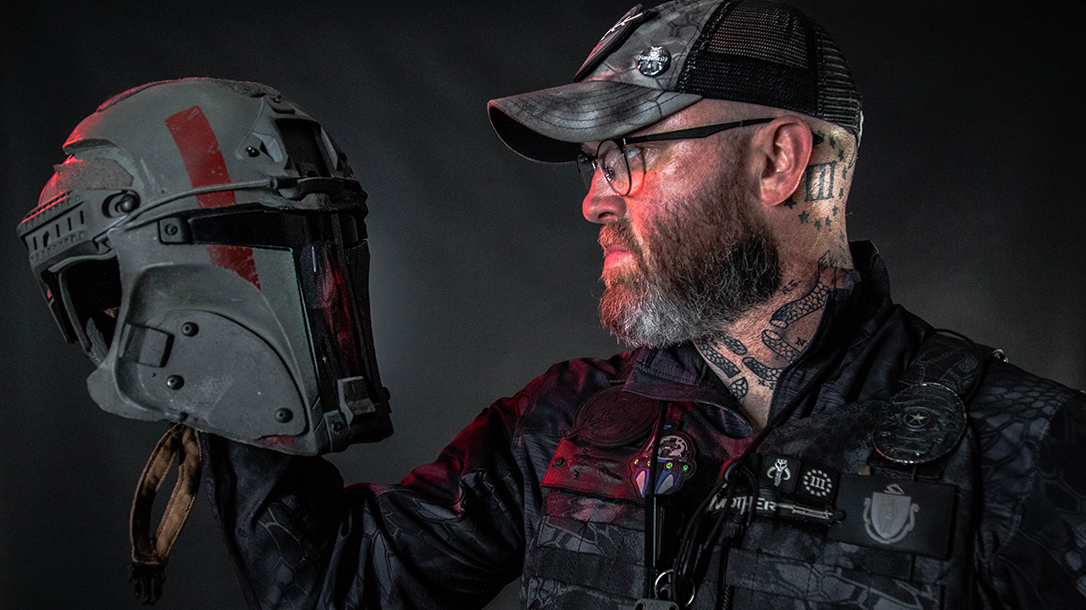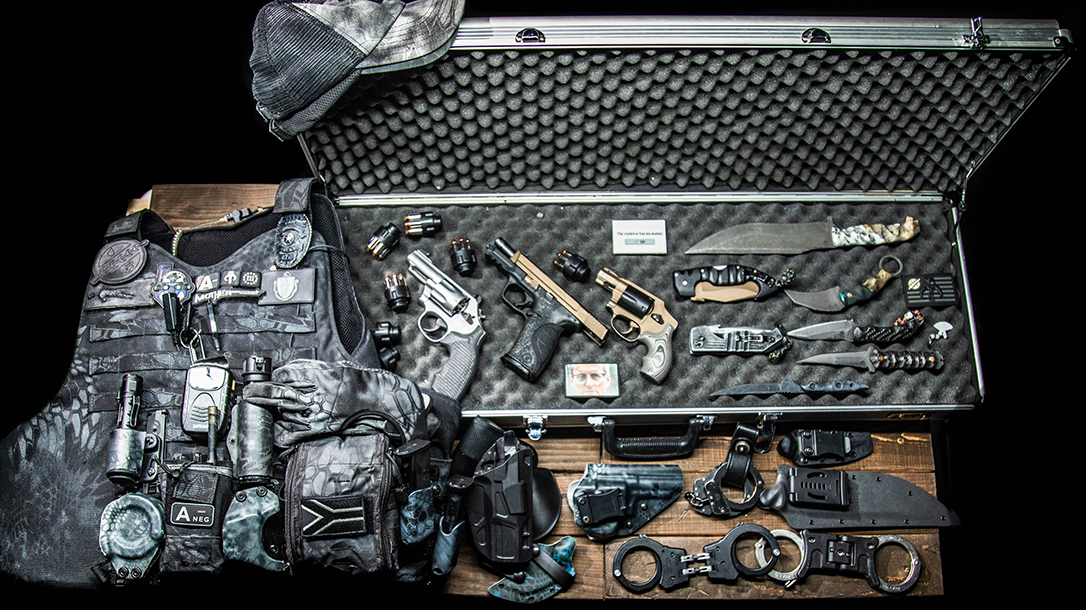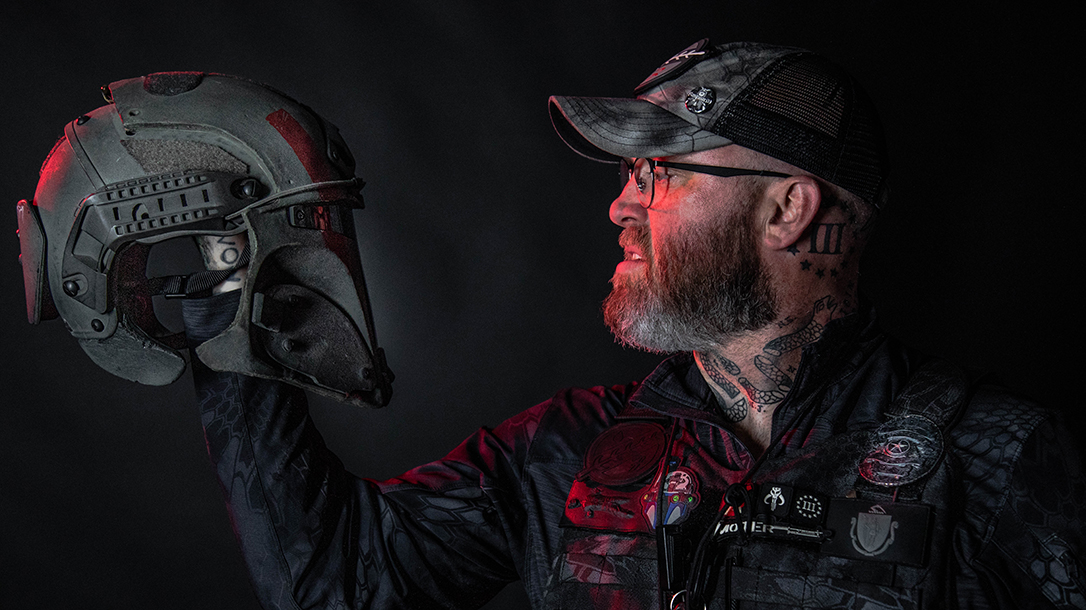“You got locked up, and you needed to get out.” The man continues: “You called my boss, and as men, you agreed and signed a private contract that you’d go to court. You also agreed to what the consequences were in advance. I’m here putting you back in jail because you couldn’t man up and do what you said you were gonna do. These are the consequences.”
Doug White – Bounty Hunter
It sounds like a line of dialogue from an intense crime thriller, right? Nope, this is real life. This is how Doug White, a 45-year-old bounty hunter from Lanesborough, Mass., succinctly sums up the dynamic between himself and the fugitives he is contracted to apprehend. Come hell or high water. Unvarnished, unapologetic and unrelenting, Doug shared his unique mission-driven perspective with regard to how and why he trains, and how he incorporates a sharp mental game, firearms, edged weapons, irritant aerosols, electronic control devices and impact weapons into his daily work.
Advertisement — Continue Reading Below
All On Camera
Chasing armed subjects through dark alleyways, fending off vicious dog attacks and dragging fugitives down from attic crawlspaces kicking and screaming—and then grappling with them on the ground to get the cuffs on—is all part of the gig. And it’s all been caught on camera in recent years. The HD body cam fixed to Doug’s plate carrier documents the realities of his work. It has also become an integral daily carry item for Doug, who has 25 years of experience in this field.
The many terabytes of video recordings capture some of Doug’s most harrowing and humorous encounters in the field. It also serves as archival evidence as well as a resource for training and education. Doug displays discipline and a wicked sense of humor. He forged it over the course of the last 13 years working as a full-time recovery agent. He says it’s serious and tough work but admits his real-life obsession with the world of bounty hunting actually began when he was a child in a galaxy far, far away.
“The thing that got me initially intrigued with the world of bounty hunting when I was a kid was Boba Fett, the most notorious bounty hunter in Star Wars. When the Empire hires him to find Han Solo, some of the Empire’s top brass talk about him as ‘bounty hunter scum,’ but at the end of the day, they needed him and his crew. Darth Vader can do a lot of things—he can choke a guy across the room—but he had to hire bounty hunters to catch those guys.”
Advertisement — Continue Reading Below
Working in the Shadows
Doug says this resonates today with how he views his symbiotic, but often challenging, relationship with local law enforcement. “No offense to the police. They have to wear a million hats and have to do what they gotta do, and they don’t have a million dollars to do it with. But at the end of the day, in a lot of ways, they can’t do what we are legally allowed to do—and we have to walk a little bit on the dark side to get the job done.”
Doug also notes that one of the greatest misconceptions about bounty hunters is just how integral they are and how much they contribute to the justice system. Because the credit is not often attributed where it is due. “We go out and apprehend a subject and turn them in to the state police or proper agency, and the next day you see in the newspaper that the very same agency ‘arrested’ said subject, with no mention of how they actually arrived at the police station in the first place. It’s not that we do it for the credit, but at the same time, this is why the industry has a bad name. The average citizen doesn’t know that we operate at zero cost to the taxpayers and apprehend 85 percent of the fugitives in this country.”
The Hunter’s Path
Doug became licensed as a fugitive recovery/bail enforcement agent by the Connecticut State Police. After a lifetime of both formal study and self-directed training and education in the defensive arts, he quickly realized that the state training requirements to become a recovery agent were in fact very minimal, requiring only 20 hours of training. Beyond that, only minor additional training was required for him to carry a firearm.
Advertisement — Continue Reading Below
A veteran of the U.S. Marine Corps, Doug says he has always had an affinity for firearms and training with them. He values the need to train on an ongoing basis to remain proficient and safe in the field. He also quickly demonstrated a knack for the work. As a novice, he succeeded in recovering fugitives while taking note of areas where he needed to improve. After his employer offered him the role of department head, he saw it as his opportunity to obtain more training. He approached the Smith & Wesson Academy, which only trained law enforcement officers at the time, and asked if he and his teammates could attend the school. They said yes, and “That’s where my formal training at an LEO level with police officers began.”
After that, Doug continued his pursuit of knowledge and tactics through many well-established courses. He even attended one at the Taser Training Academy in Scottsdale, Arizona. Here he volunteered to “ride the lightning,” or be Tased for 10 seconds. This allowed the instructors to demonstrate the device’s effectiveness. They promised to give him a Taser for free if he lasted the whole time; that’s twice as much time as Taser instructors traditionally use.
TASER!
“It hurt like hell!” Doug said. “But then, after the first one, they offered a second free Taser to anyone else who would do a 15-second ride. It was a new model, and I really wanted it. Without thinking about it, I put my hand up again. I did 10- and a 15-second rides back to back and got two Tasers out of it. Other students thought I was nuts, but hey, I got two Tasers for work, and now I know what it feels like for real.”
Advertisement — Continue Reading Below
As if that weren’t enough excitement, in the midst of a successful bounty hunting career, Doug hit the road from 2012 to 2017 to serve as high-profile bodyguard on tours with musicians like Linkin Park and the Stone Temple Pilots, just to keep things spicy.
The martial arts are an integral part of Doug’s overall background and training as well, particularly the notion of always being a humble student. For example, after Doug had amassed 20 years of Chinese martial arts training in Pai Lum kung fu. He earned fourth-degree black belt status, then chose to “start over” in Filipino martial arts as a beginner. “When you stop learning, that’s the beginning of the end. A true master is one who always starts at the beginning of his new training, regardless of his mastery.”
Getting Primal
When I asked Doug what he loves most about bounty hunting, he didn’t pull any punches. “I’m gonna be really honest with you. I like sneaking the f*ck up on people who violated their bail agreement and snatching ’em up and taking ’em with me, whether they like it or not. There’s something very primal about strapping a weapon to yourself and knowing you’re gonna go out there and apprehend somebody—somebody who agreed to this process in advance—and the local authorities approve of your actions.”
Advertisement — Continue Reading Below
Doug said he particularly enjoys the investigation process and mental aspect of tracking down and interfacing with fugitives and the community, too. “Sometimes you’re playing checkers, sometimes you’re playing chess. I give people Stockholm syndrome really quick. If you want information out of people, you gotta relate to them. And I don’t bullshit people. I look them in the eye and level with them about what’s going to happen. And if you wanna connect with people, the best way is to make them laugh. If I have to get abrasive, I can do that too, but you catch a lot more flies with honey than vinegar.”
The seriousness of the job is never lost on Doug. He makes sure his team knows it when they brief before a recovery operation. “You have to believe in the mission. I tell my team it doesn’t take much to lose. All that has to happen today for you to die is for that guy to not want to go back to jail more than you want to put him there. You’re in his world when you kick in that door. When it comes time, you better believe in the mission.”
The Right Tools
Doug admits that his custom Kryptek Typhon plate carrier, covered in gear, strikes a lot of people as overkill. However, pound for pound and piece for piece, every tool has a job. He actually carries fewer total pieces of kit than a beat cop.
Advertisement — Continue Reading Below
Every piece of Doug’s kit—especially the essentials, like handcuffs and OC gel spray—is arranged specifically to be ambidextrously accessible, whether he’s standing or in a scuffle on the ground. He also has the advantage, in his jurisdiction, of being allowed to carry what local police are restricted from carrying. In his case, this happens to be one of his specialties: edged weapons. “Depending on what agency you’re with, some don’t let you carry a fixed-blade knife on your belt, whereas I can for example.”
When asked for a quick rundown on the most important pieces of kit and how they’re used, Doug said, “Two sets of handcuffs, one rigid and lockable. This helps with larger subjects as well, when linked together, for a subject’s comfort. They also help me gain leverage on a subject’s wrist and maintain control through pain compliance. My radio—communication is key for the team. OC pepper gel in a 10-ounce canister. The gel is better because spray gets blown around and gets on everyone. The gel helps maintain a stable stream. If someone squares up with me, the first thing they’re gonna eat is some pepper gel. I’d rather quickly gain compliance with a little non-lethal pepper gel and have you deal with a little burning before it comes to blows.”
Showing off an arsenal in a padded carrying case that would make John Wick blush, Doug turned his attention to his fixed-blade knife collection; it includes hardware from Half Face Blades, CRKT and TOPS. He also carries a compact crowbar for breaching, a window punch, extra magazines for his S&W M&P40 with the beavertail ground off, an individual first-aid kit (IFAK) and a collection of wheelguns, to name just a few items.
Advertisement — Continue Reading Below
CQB Style
“I also have a duty rifle and a shotgun. But I don’t tend to utilize long guns too often, mainly because what we do most often requires us to go hands on and we are operating in tight quarters, going through closets, digging through heaps of clothes. And then you go hands on to bring ’em out.”
Beyond gear, it also takes a very cool head. A commanding presence and a hell of a lot of patience remain requirements to do this kind of work. Just think of the hairy situations he has to deal with on a daily basis, like dog attacks. “I got attacked by a subject’s pit bull recently, and because I know my kit so well and place each item so it’s accessible with both right and left hands, I was able to access my pepper gel while holding the dog back by its throat.” The dog took a bite out of Doug’s thumb before eating half a can of OC gel, and both he and the pooch lived to fight another day.
Advertisement — Continue Reading Below
How does he handle that kind of stress? “To quote Daniel Boone, ‘I was happy in the midst of dangers and inconveniences.’ If you can’t say that about this job, then you need to get the f*ck out of it. But if you love it and embrace it, it’s all just fun.” For more, follow Doug on Instagram: @bountyhuntercam.
This article is from the December 2019 issue of Tactical Life magazine. Grab your copy at OutdoorGroupStore.com. For digital editions, visit Amazon.






























